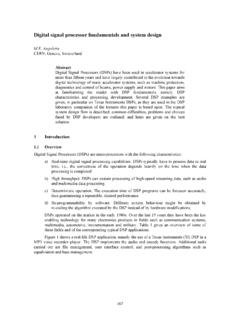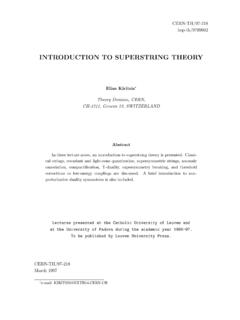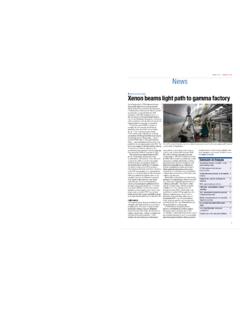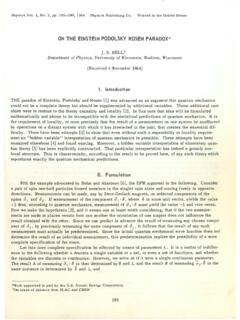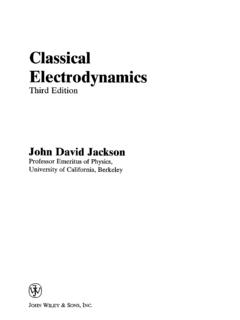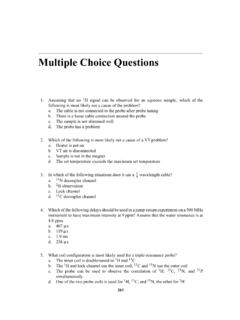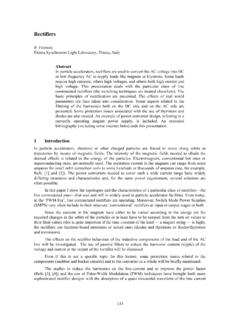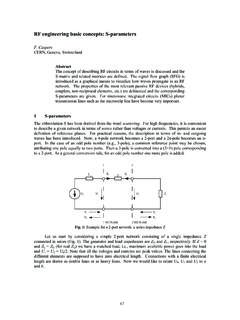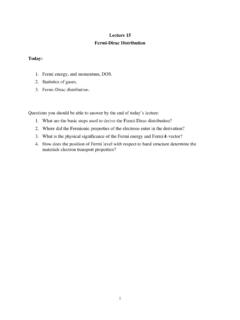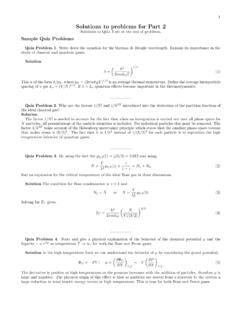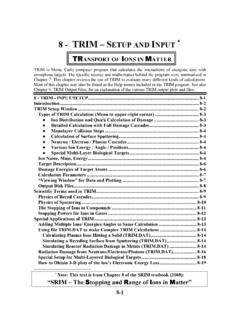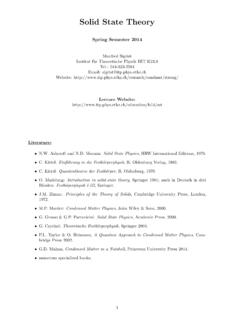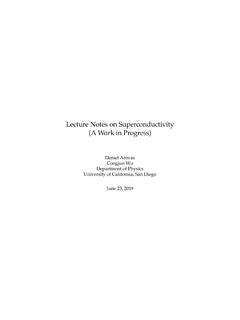Transcription of Material Properties at Low Temperature - CERN
1 Material Properties at Low Temperature P. Duthil1 Institut de Physique Nucl aire d Orsay, IN2P3-CNRS/Universit de Paris Sud, Orsay, France Abstract From ambient down to cryogenic temperatures , the behaviour of materials changes greatly. Mechanisms leading to variations in electrical, thermal, mechanical, and magnetic Properties in pure metals, alloys, and insulators are briefly introduced from a general engineering standpoint. Data sets are provided for materials commonly used in cryogenic systems for design purposes.
2 Keywords: cryogenics, diffusion of heat, electrical conductivity, mechanical Properties . 1 Introduction The Properties of materials are used in specific equations to predict the behaviour of a system. They depend on chemical composition, crystalline architecture, atomic and charge interactions, heat or mechanical treatments, etc., and are affected by Temperature changes. Thus, understanding the mechanisms that contribute to relevant Properties is important when considering changes in materials with Temperature .
3 For details about transport phenomena Properties in matter ( thermal or electrical Properties ), one can refer to any textbook on solid-state physics (see, for example, Refs. [1, 2]). Magnetism or superconducting states also affect Material Properties . The reader is encouraged to refer to dedicated lectures (which are too specific to be presented here) at the CERN Accelerator School. References on data concerning materials used in cryogenics are given in Ref. [3]. 2 Thermal Properties The thermal (and electrical) Properties of any Material are related to the vibrations of its atoms around their equilibrium positions (in a lattice crystal).
4 The amplitude of these vibrations depends on Temperature and diminishes as the Temperature decreases. Note that the se vibrations may propagate within the Material at the speed of sound, and are studied as plane waves, with which phonons are associated. Thermal Properties also depend on the movements of negative charges (electrons) and positive charges (vacancies) if the Material is a conductor. Heat capacity The heat capacity C is defined as the quantity of energy (heat) that must be introduced into some mass of Material to increase its Temperature T by 1 K.
5 Reversibly, it is the quantity of energy extracted from this mass of Material to decrease its Temperature by 1 K. The unit of this extensive quantity is J K 1. The intensive property is given by the specific heat c, which is the heat capacity or thermal capacity per unit of mass (J kg 1 K 1) or the molar heat capacity (J mol 1 K 1). The heat capacity of a Material is thus its ability to store or release heat energy. It is an important property in cool-down or warm-up processes used in the estimation of the energy (and cost) involved, and in the 1 assessment of the transient states of the heat transfer as it relates to the thermal diffusivity (see Section ).
6 As the Temperature tends to zero, so does the heat capacity. Heat can be supplied at constant volume V or constant pressurep, defining two heat capacities such that: VVVSUCTTT == , pppSHCTTT == , (1) where S is the entropy, U is the internal energy, and H is the enthalpy (all having units of joules, J). For a system comprising the association of several homogenous materials i each having a mass im: iViViCmc= and ipipiCmc= . (2) For solids at low temperatures , the difference pVCC is negligible (less than 1%), and thus no distinction will be made in the following between VC and pC.
7 Crystal lattice contribution Considering the sum of the energies of the phonon modes, the Debye model enables the expression of the total energy of the crystal lattice as a function of the Debye Temperature D : D333DB30/D9d3e1 TxTxUNkxR DT == , (3) with 1/ 3phDB34vNkV = , 33303de1xttDtx= , (4) where 10k = J K 1 is the Boltzmann constant, 10 = J s is the reduced Planck constant, phv is the speed of sound in the Material , /NVis the number of atoms per volume of Material , and 3D is called the third Debye function.
8 The Debye Temperature of some materials is given in Table of Appendix A. For 1n= mole of Material , noting that BAR kN= and that ANnN=, the derivation of Eq. (3) with respect to the Temperature gives the crystal lattice contribution to the molar heat capacity phc (the subscript ph refers to phonons): ()D/34ph20De3d3e1xxTcTxxR = . (5) It follows that, for any Material , the ratio ph/ (3 )cRcan be plotted as a unique function of D/T , as shown in Fig. 1. As T increases, ph/ (3 )cR tends to 1 (see the black solid curve of Fig.)
9 1) and thus ph3cR . For DT <<, the limit of phc can be found to be 34D( /) 12/ 5T , showing a cubic dependence of the lattice heat capacity with respect to the Temperature (see the grey dashed line of Fig. 1). Fig. 1: ph/ (3 )cR as a function of D/T ; solid black curve and black axis for D/[0; ]T ; dashed grey curve and grey axis for ph/ (3 ) [0; ]cR . Contribution of free electrons Thermal excitation induced by heating concerns only a fraction of the electrons for which the energy is within BkT of the fermi energy,22/3Fe( / 2)(3/ )EmNV = , where 10m = kg is the mass of an electron .
10 The total energy of the electrons is FB(/)UN T T kT , where F FB/T Ek= is called the fermi Temperature . The electronic heat capacity given by the free - electron -gas model thus evolves linearly with respect to the Temperature : ()eF-1B/(/ )unit: J KCUTT T Nk= . (6) At temperatures much lower than the fermi Temperature , the molar heat capacity (of free electrons) can be expressed by 2eBF /CNk T T = . Heat capacity of materials The heat capacities of different materials (metals, thermal insulators, and gases for comparison) are plotted in Fig.
